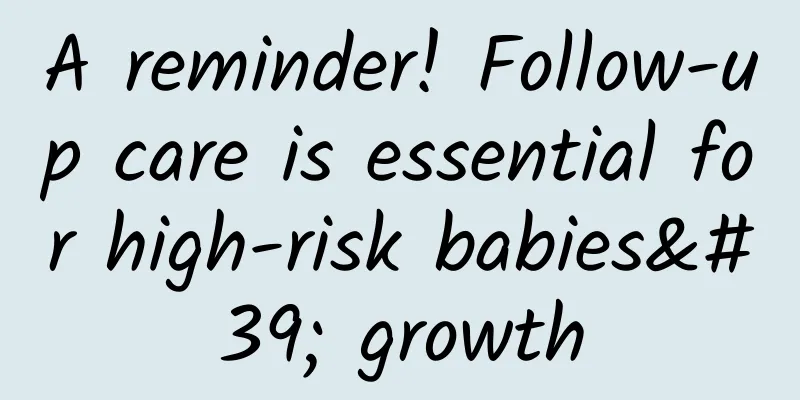A reminder! Follow-up care is essential for high-risk babies' growth

|
Experts from Yiyang Central Hospital said that high-risk babies are newborns whose mothers have various high-risk factors that may affect their physical and mental development before pregnancy, during pregnancy, at birth, after birth, and after discharge from hospital . 1. What are the common high-risk factors? 1. Maternal factors The mother has a history of hypertension or diabetes; the mother has a serious infection (such as rubella virus, cytomegalovirus); the mother has a history of sexually transmitted diseases (such as syphilis, HIV); the mother has a history of smoking, alcoholism, and drug abuse during pregnancy, etc. 2. Abnormal pregnancy History of abnormal pregnancy and delivery; history of difficult labor; multiple pregnancy; use of sedatives and analgesics during delivery, etc. 3. Abnormalities at birth Premature babies, babies small for gestational age, and babies with macrosomia; various congenital malformations or genetic metabolic diseases; history of asphyxia and hypoxia or even cerebral hemorrhage at birth, Apgar score less than 7 points; history of pathological jaundice and infectious diseases in the neonatal period. 2. What abnormalities may occur in high-risk children? 1. Abnormal physical development: such as malnutrition, dwarfism, obesity, etc.; 2. Motor development delay/disorder; 3. Speech delay; 4. Intellectual development disorder; 5. Hearing and vision abnormalities; 6. Developmental and behavioral abnormalities: such as autism, ADHD, etc.; 7. Secondary epilepsy. 3. How to follow up and manage high-risk children? 1. Follow-up time Check once a month within 6 months (at 1 month, 2 months, 3 months, 4 months, 5 months, and 6 months); After 6 months, check every 2 months (8 months, 10 months, and 12 months); After 12 months of age, check every 3 to 6 months (15 months, 18 months, 21 months, and 24 months). 2. Follow-up content Height, weight and head circumference measurement (to determine physical development); Neurobehavioral assessment (to determine the development of brain function); Eye care and ear care; Feeding guidance, disease prevention and early development guidance for high-risk infants; Others: blood tests and other examinations (follow-up according to the specific situation of the high-risk infant). 4. Warning Sign Screening Form Parents can refer to the following table. If your child shows any corresponding abnormalities, please seek medical attention in time for professional evaluation. References [1] Chinese Journal of Pediatrics Editorial Committee, Neonatology Group, Chinese Society of Pediatrics. Expert consensus on classification and grading management of high-risk neonates[J]. Chinese Journal of Pediatrics, 2023.61(10):869-873. [2] Infant and Child Development Professional Committee of China Eugenics Association. Expert consensus on early intervention for behavioral neurodevelopment of high-risk newborns[J]. Chinese Journal of Child Health Care, 2022, 30(3): 233-236 Hunan Medical Chat Special Author: Liu Lin from Yiyang Central Hospital Follow @湖南医聊 to get more health science information! (Edited by YT) |
>>: What are the symptoms of esophageal cancer? You can do this to prevent esophageal cancer
Recommend
Why are kiwis available all year round? Should kiwis be kept in the refrigerator in summer?
Kiwi fruit, also known as kiwi fruit, is oval in ...
Does taking estrogen increase breast size? Is it good to take estrogen regularly?
Breast enhancement is a subject that girls study ...
"How to protect your eyes while staying at home" themed science event
Eye care As the 2022 June 6 "Eye Care Day&qu...
Why isn't my girlfriend pregnant?
We all know that pregnancy is a matter between a ...
Placenta falls out with blood clots after medical abortion
Medical abortion is a method of abortion that man...
A brief discussion on Pneumocystis carinii pneumonia
This is the 3776th article of Da Yi Xiao Hu What ...
Will a 19-year-old girl's breasts still grow bigger?
The breasts of a 19-year-old girl are in the stag...
How to tell if a female dog is really pregnant or not How to avoid a female dog getting pregnant
The reproduction method of dogs is similar to tha...
Dry skin on vulva
Vulvar furunculosis is a subacute suppurative inf...
What should pregnant women do if they drink almond milk?
After a woman becomes pregnant, she needs to pay ...
Mid-luteal phase
The follicular phase refers to the period from ov...
What are the symptoms of late pregnancy?
In the blink of an eye, it's already ten mont...
Why do breastfeeding women have stomach pain?
The breastfeeding period is also a very critical ...
How big is the fetus at nine weeks of pregnancy
The size of the fetus when a woman is nine weeks ...









